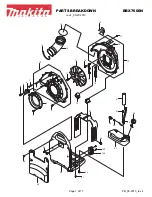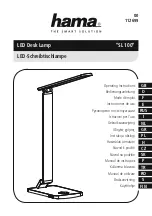
Current Options
3. The
Current Options
includes the slider used to control the current sent to the light source.
• When using some
LED
module, the
Overdrive
checkbox will appear. When selected, this allows the system
to exceed the normal safe current limit of the light source.
THIS SHOULD ONLY BE USED WITH PULSED
SIGNALS, AS IT CAN OTHERWISE DAMAGE THE LIGHT SOURCE.
• When using a
CLED
module, the
Low-Power
checkbox will appear. When selected, this allows reduced-
power signaling for the same voltage. This mode is only available for
CLED
modules. This allows low-power
signals to be more stable in time. The maximal current is reduced to one tenth of light source’s normal
maximal current. If the
BNC Output
is used to monitor the LED power, its output voltage is proportional
to the current passing through the light source, and not the voltage sent to it. For example, a driver with a
normal maximum current of 2000 mA for a 5 V signal (400 mA/V) will have a maximum current of 200 mA
for a 5 V signal (40 mA/V) in low power mode. The
BNC output
of the driver will still relate LED current
with a 400 mA/V conversion factor.
Trigger Options
4. The
Type
defines the type of trigger that is used to start/stop a sequence. The
Triggered
type can starts and
stops a sequence at a rising edge while the
Gated
type can starts the sequence at a rising edge and stops it at a
falling edge. A more refined interaction of the trigger with the defined sequence can be set up using the
Mode
field. Not all Trigger Type are available for each combination of Trigger Mode and Repeatability. The different
combinations are shown in Figure
5. The
Mode
field defines how the trigger activates a sequence. Each mode are not compatible with each combi-
nation of trigger type and repeatability. Figure
shows the different available combinations for the different
Trigger Modes. Four Modes are available and are the following:
•
Uninterrupted
: This mode activates the channel sequence when an input greater than 3.3 V is detected
by the BNC input. Following input pulses will be ignored while the sequence is running (Fig.
). When
the
Repeatable sequence
checkbox is checked, the sequence will restart with the arrival of the first input
pulse after the sequence has finished (Fig.
). This mode is available for
Triggered
pulse only.
•
Pause
: This mode activates the channel sequence when a rising edge greater than 3.3 V is detected on
the BNC input (Fig.
). Following input pulses (when
Triggered
, Fig.
) or falling edge (when
Gated
,
Fig.
) will pause the sequence and the sequence will continue when the next rising edge is received.
When the
Repeatable sequence
checkbox is checked, the sequence will restart with the arrival of the first
input pulse after the sequence has finished (Figs.
and
•
Continue
: This mode activates the channel sequence when a rising edge greater than 3.3 V is detected on
the BNC input (Fig.
). The following input pulse (when
Triggered
, Fig.
) or a falling edge (when
Gated
,
Fig.
) will turn off the output, but the sequence will continue. The output will be turned back on at the
reception of the following rising edge. Triggers only affect the output voltage value. When the
Repeatable
sequence
checkbox is checked, the sequence will restart with the arrival of the first input pulse after the
sequence has finished (Figs.
and
•
Restart
: This mode activates the channel sequence when a rising edge higher than 3.3 V is detected on the
BNC input. The following input pulse (when
Triggered
, Fig.
) or falling edge (when
Gated
, Fig.
) will
stop the sequence and the sequence will restart from the beginning when the next rising edge is received.
When the sequence is completed, it will restart with the next input pulse.
Chapter 4. Doric Neuroscience Studio
15














































